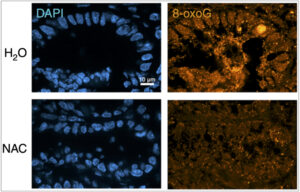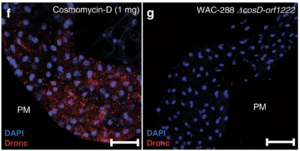
Microblog
 Pathogenic microbes have evolved diverse tools to invade and infect their hosts. Many bacterial pathogens produce effector proteins, which are delivered into the host cell and hijack host processes to enable virulence. The study of effector-host protein interactions is challenging because they are dynamic, transient, and often involve insoluble membrane proteins (Weigele et al. 2017). Traditional affinity-purification based methods are often insufficient to capture this interaction network, as only stable soluble protein complexes are well recovered. In the lab of Dr. John Brumell at SickKids, Dr. D’Costa and colleagues performed the first systematic investigation of bacterial effector-host protein interactions using proximity-dependent biotin identification (BioID). Their work, reported here, describes the discovery of novel effector targets and provides a detailed analysis of the molecular mechanisms by which the Salmonella effector SifA manipulates host processes to favour intracellular bacterial growth. This study highlights the immense power of BioID in the characterization of effector protein interactions.
Pathogenic microbes have evolved diverse tools to invade and infect their hosts. Many bacterial pathogens produce effector proteins, which are delivered into the host cell and hijack host processes to enable virulence. The study of effector-host protein interactions is challenging because they are dynamic, transient, and often involve insoluble membrane proteins (Weigele et al. 2017). Traditional affinity-purification based methods are often insufficient to capture this interaction network, as only stable soluble protein complexes are well recovered. In the lab of Dr. John Brumell at SickKids, Dr. D’Costa and colleagues performed the first systematic investigation of bacterial effector-host protein interactions using proximity-dependent biotin identification (BioID). Their work, reported here, describes the discovery of novel effector targets and provides a detailed analysis of the molecular mechanisms by which the Salmonella effector SifA manipulates host processes to favour intracellular bacterial growth. This study highlights the immense power of BioID in the characterization of effector protein interactions.
Salmonella spp. are amongst the leading agents of foodborne diseases (Mead et al. 1999). Their success as pathogens is largely due to the dozens of effector proteins expressed during infection. Many Salmonella effectors are known to manipulate host cell machinery, enabling the formation of Salmonella-induced filaments (Sifs) and an intracellular replicative niche called the Salmonella-containing vacuole (Figueira and Holden 2012). This unique vacuole is crucial to provide a “safe-site” for bacterial replication, shielded from host cell insults (Dunlap et al. 1991; Tuli and Sharma 2019). The targets of five Salmonella effectors were investigated systematically by BioID and by classical immunoprecipitation mass spectrometry (IP-MS). BioID has been widely successful in screening endogenous, physiologically relevant protein interactions in mammalian cells (Roux et al. 2012; Liu et al. 2018). In this approach, a bait protein is fused to a biotin ligase which irreversibly labels proteins within ~10 nm (Kim et al. 2014). Applying this technique to five effectors with established roles in Sif formation unveiled >300 unique human protein hits, more than three times that identified by IP-MS. Validating this approach, BioID experiments identified well-known effector-target interactions and, proteins were representative of specific subcellular compartments that each effector was previously known to manipulate. While having distinct roles and targets, the five Salmonella effectors under investigation shared characterized functions on membrane-bound compartments. Unlike IP-MS, proteins identified by BioID were enriched for integral membrane proteins. Overall, these new protein networks emphasized effectors’ roles in manipulating vesicular trafficking, cytoskeleton components and transport activities.
Sif formation is regulated in part by the effector SifA, although the molecular mechanism(s) through which this occurs are not fully understood. In this work, new targets of SifA were identified, revealing that SifA specifically binds to BLOC-2, a host multi-subunit complex that participates in lysosomal trafficking (Li et al. 2014). SifA was demonstrated to manipulate BLOC-2 mediated trafficking to control the stability and positioning of Salmonella-containing vacuoles.
The observation that BioID and IP-MS identified different sets of proteins emphasizes the value of using complimentary approaches to dissect complex host-pathogen interactions. A better mechanistic understanding of how bacteria manipulate host cells to allow for intracellular survival may reveal therapeutic targets to interrupt these processes and clear devastating bacterial infections.
Primary Research Article:
D’Costa VM, Coyaud E, Boddy KC, et al. BioID screen of Salmonella type 3 secreted effectors reveals host factors involved in vacuole positioning and stability during infection. Nat Microbiol. 2019;4:2511-2522. doi.org/10.1038/s41564-019-0580-9
Other References:
Weigele BA, Orchard RC, Jimenez A, Cox GW, Alto NM. A systematic exploration of the interactions between bacterial effector proteins and host cell membranes. Nat Commun. 2017;8(1):532. doi:10.1038/s41467-017-00700-7
Mead PS, Slutsker L, Dietz V, et al. Food-related illness and death in the United States. Emerg Infect Dis. 1999. doi:10.3201/eid0505.990502
Figueira R, Holden DW. Functions of the Salmonella pathogenicity island 2 (SPI-2) type III secretion system effectors. Microbiology. 2012;158(5):1147-1161. doi:https://doi.org/10.1099/mic.0.058115-0
Dunlap NE, Benjamin WH, McCall RD, Tilden AB, Briles DE. A ‘safe-site’ for Salmonella typhimurium is within splenic cells during the early phase of infection in mice. Microb Pathog. 1991;10(4):297-310. doi:https://doi.org/10.1016/0882-4010(91)90013-Z
Tuli A, Sharma M. How to do business with lysosomes: Salmonella leads the way. Curr Opin Microbiol. 2019;47:1-7. doi:https://doi.org/10.1016/j.mib.2018.10.003
Roux KJ, Kim DI, Raida M, Burke B. A promiscuous biotin ligase fusion protein identifies proximal and interacting proteins in mammalian cells. J Cell Biol. 2012;196(6):801-810. doi:10.1083/jcb.201112098
Liu X, Salokas K, Tamene F, et al. An AP-MS- and BioID-compatible MAC-tag enables comprehensive mapping of protein interactions and subcellular localizations. Nat Commun. 2018;9(1):1188. doi:10.1038/s41467-018-03523-2
Kim DI, KC B, Zhu W, Motamedchaboki K, Doye V, Roux KJ. Probing nuclear pore complex architecture with proximity-dependent biotinylation. Proc Natl Acad Sci. 2014;111(24):E2453 LP-E2461. doi:10.1073/pnas.1406459111
Li K, Yang L, Zhang C, Niu Y, Li W, Liu J-J. HPS6 interacts with dynactin p150Glued to mediate retrograde trafficking and maturation of lysosomes. J Cell Sci. 2014;127(21):4574 LP – 4588. doi:10.1242/jcs.14197




